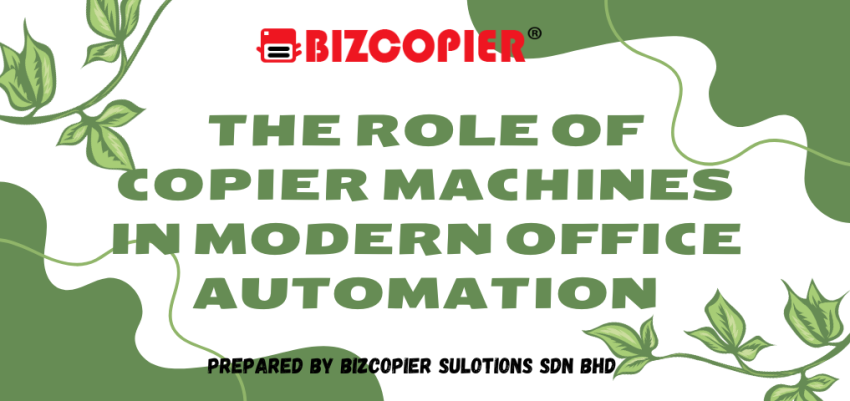Introduction
In the era of digital transformation, copier machines have transcended their traditional role of mere document duplication. They have become integral components of modern office automation, driving efficiency, productivity, and collaboration. This article examines the evolving role of copier machines in office automation, highlighting their advanced capabilities and the impact they have on business operations.
The Shift Towards Office Automation
Digital Workflows: The push towards digital workflows has transformed how businesses handle documents. Copier machines now serve as hubs for digitizing paper documents, enabling seamless integration into digital systems and workflows. This shift reduces reliance on paper, improves document accessibility, and enhances collaboration.
Integration with Business Applications: Modern copiers can integrate with various business applications such as document management systems (DMS), enterprise resource planning (ERP) systems, and customer relationship management (CRM) software. This integration streamlines processes, reduces manual data entry, and ensures that information flows smoothly across different platforms.
Advanced Capabilities of Modern Copier Machines
Smart Scanning: Advanced scanning features allow copier machines to perform intelligent document capture. They can automatically detect and categorize documents, extract relevant data using optical character recognition (OCR), and route the information to appropriate digital repositories or workflows.
Automated Workflows: Copier machines can be programmed to execute complex workflows automatically. For example, a scanned invoice can be automatically forwarded to the accounts payable department, checked against purchase orders, and entered into the financial system. This automation reduces manual intervention, minimizes errors, and speeds up processing times.
Enhanced Collaboration: By enabling easy sharing and distribution of documents, copiers enhance collaboration within and between teams. Features like scan-to-email, cloud integration, and mobile access allow employees to share documents quickly and securely, regardless of their location.
Mobile and Remote Access: With the rise of remote work, the ability to access copier functions from mobile devices has become increasingly important. Modern copiers support mobile printing and scanning, allowing employees to print from or scan to their smartphones and tablets. This flexibility is essential for maintaining productivity in a mobile workforce.
Security and Compliance
Data Protection: Copier machines handle sensitive information, making data protection a critical concern. Modern copiers come equipped with advanced security features such as user authentication, secure print release, data encryption, and audit trails. These features ensure that only authorized users can access documents and that data remains secure during transmission and storage.
Regulatory Compliance: Many industries are subject to strict regulatory requirements regarding data handling and document management. Copier machines help businesses comply with regulations by providing features like secure document storage, automatic deletion of sensitive data, and detailed logging of document activities.
Sustainability and Cost Efficiency
Eco-Friendly Design: Manufacturers are focusing on making copiers more environmentally friendly. Energy-efficient designs, reduced power consumption, and the use of recyclable materials contribute to lower environmental impact. Features like duplex printing and toner-saving modes further reduce paper and consumable usage.
Cost Savings: By automating workflows and reducing reliance on paper, copier machines can lead to significant cost savings. Lower consumable usage, reduced need for physical storage space, and improved operational efficiency all contribute to a more cost-effective office environment.
Practical Tips for Maximizing the Benefits of Copier Machines
Regular Training: Ensure that employees are well-trained on the advanced features and capabilities of the copier machines. Regular training sessions can help users stay up-to-date with new functionalities and best practices.
Leverage Automation: Identify repetitive tasks that can be automated using the copier’s workflow capabilities. This can include document routing, approval processes, and data entry tasks. Automating these processes can free up employee time for more value-added activities.
Monitor and Optimize Usage: Use the copier’s monitoring tools to track usage patterns and identify areas for optimization. This can include setting print quotas, encouraging duplex printing, and optimizing document workflows to reduce waste and improve efficiency.
Implement Security Measures: Take full advantage of the copier’s security features to protect sensitive information. Implement user authentication, enable secure print release, and regularly review access logs to ensure compliance with security policies.
Conclusion
Copier machines have evolved into powerful tools that play a vital role in modern office automation. Their advanced capabilities in smart scanning, automated workflows, and enhanced collaboration are transforming how businesses operate. By leveraging these features, organizations can improve efficiency, enhance security, reduce costs, and drive sustainability. Staying informed about the latest developments and best practices in copier technology will ensure that businesses continue to reap the benefits of these indispensable devices.
Lorem ipsum dolor sit amet, consectetur adipiscing elit. Ut elit tellus, luctus nec ullamcorper mattis, pulvinar dapibus leo.

